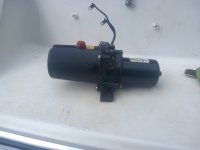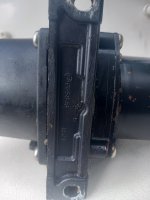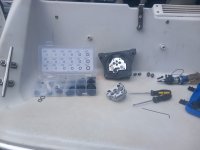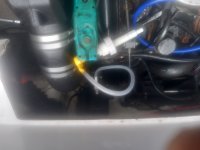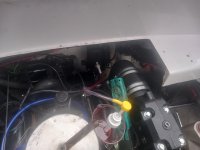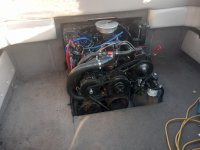Thanks Lou, it did occur to me (think I mentioned it a few posts back on this thread) to connect the alternator voltage sense wire to B+ instead of the ignition on wire. Didn't know (still don't) whether there'd be a constant battery drain with the engine off if I did that? If there was a chance of battery drain my other idea was to fit a relay switched by the purple ignition on wire to connect the alternator voltage sense to B+. Didn't occur to me about the alternator earth reference wire and I take your point, seems a good idea but I can't see there being much more than a tiny fraction of a volt drop on the earth?
I've had the boat on the river today and consider it a great success but with a couple of little problems. I already told some friends on another forum (not a boating forum) about today's events so to save me retyping / rewording the same info I'll just copy and past my post below...
Yes I remembered to put the plug in, I did that the other day to make sure I didn't forget today lol.
It went great!
Got up this morning, had a big breakfast, did a few bits on the boat (that I had to do really) such as tidy up remaining tools, nuts and bolts, check the fill level and dipstick seals on the drive, refit the drive cover, temporary fit a trim panel that runs across the width between the swim platform and rear of the engine bay, secure everything (such as bimini / weather cover), fit the number plate to the trailer board, fit the trailer board, fit the road cover, go to the garage to get 5 gallons of super unleaded in a jerry can, pour jerry can into boat fuel tank. Doesn't sound much but it was 1pm before I'd got that done.
Easy launch at around 2pm, reversed at steady speed into the water then hit the brakes and the boat slid off backwards while the missus held onto a bow rope. Didn't get back home until around 830pm hence the late post. First thing I did after launching was make sure water wasn't p***ing into the bilge... A missing drain plug would be last of my worries if (e.g.) there was a big leak on the bellows or cooling system inlet.
Dropped the leg on the hydraulics, trim gauge working perfectly. Gave it a couple of pumps on the throttle, returned throttle to a slight opening / fast idle position, turned the key and it burst into life first attempt and sounded great. Oil pressure 40psi, all gauges working except the tacho (revounter) reads what I think is double rpm. Let it idle for a minute while I hand monitored water cooled exhaust manifold temperatures, all good. Forward and reverse gears engaged perfectly. I let the others come onboard and we cast off.
Loads of boats moored on the river in the area of the launch site so had to go steady past them (there's a supposed 5 knots speed limit and wouldn't want to cause much wake past moored boats) but would have gone steady anyway because the engine is newly rebuilt and needs some running in. Even going steady I kept slightly changing throttle position to vary the rpms/load a bit, it's best to keep varying rpm/load when running in a rebuilt engine.
After around half an hour an open bit of river, no moored boats or fishermen, slowly increased the throttle to around half throttle (still too early to gun it), easily up on the plain and up to around 30mph no problem and without ever going above maybe 2500rpm. Soon brought it back down to a slower speed again because it's still running in. The dash temp gauge did go from 140degF to around 180degF during the short bit of half throttle, that's not a problem if the temps really are 140 and 180 (I'm not sure the gauge is fully accurate) but the 40F increase was another reason I pulled it back. I think this will be normal but I'll be asking on boating forums anyway.
The hydraulics were working fine but I tried adjusting trim under load (trim up slightly on the plain) and didn't hear the trim motor run and it hasn't run since. I don't know what the problem with that is yet, worst case scenario a broken trim motor but could be something as simple as an electrical connection that needs cleaning up (the trim system gets power from an electronics box on the engine), a tripped circuit breaker (again one fitted on the engine just for the trim motor). I left the boat moored on the river for a few days and will be visiting it again sometime tomorrow so I'll take a multimeter and some wire in case I want to test by powering the trim motor direct from a battery (bypass all control systems and solenoids).
Stopped the boat a few times and checked oil level / condition. It's not as easy to check condition on the boat engine as it is with a car application because the dipstick tube runs under the sump... the oil you see on the stick will give you correct level but doesn't really tell you much about condition because the oil in the tube will probably stay new looking regardless of condition of oil in the sump. But the oil level was still bang on the top of the stick hatched area aftar around 5 hours of running, which is good. Obviously wouldn't want the oil level to go down but (obvious to mechanics) wouldn't want it to go up either as that could point to water entering oil (again would be difficult to tell on the boat because you can't tell much about oil condition by reading the stick).
Got to get the hydarulics / trim working somehow. It's OK in the fully trimmed down position for use on the river but I can't get the boat out of the water with the drive leg fully down (it will catch on the riverbed when putting it on the trailer or on the road if I managed to get it on the trailer). If the trim pump/motor assembly is broken there are 2 ways to lift the drive leg, either unbolt the hydraulic rams from the drive leg or disconnect the hydraulic lines at the pump/motor and manually lift the leg. Hope to find it's just a bad connection or broken switches/solenoids (which can be bypassed).
All considered I consider its first test a great success only let down by the trim system stopping working and to a lesser extent by the tacho reading double rpm. Plenty poke in the engine now, sounds great, no knocking noises etc, no unusual vibrations, it's supposed (by the boat maker) to be able to do around 47mph and it feels like it'll probably manage that but I'll only put it to the test when I've put more hours on the newly rebuilt engine.
I'm pleased

